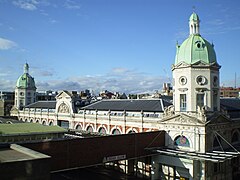
Back Smiþþfeld, Lunden ANG Smithfield Welsh Smithfield (Londres) Spanish اسمیتفیلد، لندن Persian Smithfield (Lontoo) Finnish Smithfield (Londres) French Smithfield Irish Smithfield (Londra) Italian スミスフィールド Japanese Smithfield (London) NB
| Smithfield | |
|---|---|
 Smithfield Meat Market | |
Location within Greater London | |
| Sui generis | |
| Administrative area | Greater London |
| Region | |
| Country | England |
| Sovereign state | United Kingdom |
| Post town | LONDON |
| Postcode district | EC1 |
| Dialling code | 020 |
| Police | City of London |
| Fire | London |
| Ambulance | London |
| UK Parliament | |
| London Assembly | |

Smithfield, properly known as West Smithfield,[1] is a district located in Central London, part of Farringdon Without, the most westerly ward of the City of London, England.
Smithfield is home to a number of City institutions, such as St Bartholomew's Hospital and livery halls, including those of the Butchers' and Haberdashers' Companies. The area is best known for the Smithfield meat market, which dates from the 10th century, has been in continuous operation since medieval times,[2] and is now London's only remaining wholesale market. From the 12th century to the 19th century the area hosted Bartholomew Fair. Smithfield's principal street is called West Smithfield,[3][4] and the area also contains the City's oldest surviving church building, St Bartholomew-the-Great, dating from 1123 (most City churches were destroyed in the Great Fire of 1666).
The area has borne witness to many executions of heretics and political rebels over the centuries,[5] as well as Scottish knight Sir William Wallace, and Wat Tyler, leader of the Peasants' Revolt, among many other religious reformers and dissenters.
Smithfield Market, a Grade II listed-covered market building, was designed by Victorian architect Sir Horace Jones in the second half of the 19th century, and is the dominant architectural feature of the area.[6] Some of its original market premises fell into disuse in the late 20th century and faced the prospect of demolition. The Corporation of London's public enquiry in 2012[7] drew widespread support for an urban regeneration plan intent upon preserving Smithfield's historical identity.[8]
- ^ Brewers Dictionary of London Phrase and Fable, Russ Willey, Chambers 2009
- ^ "Visitor Info - Smithfield Market". www.smithfieldmarket.com.
- ^ "West Smithfield Rotunda Garden - City of London". www.cityoflondon.gov.uk. Archived from the original on 31 January 2018. Retrieved 30 November 2014.
- ^ Renamed in 1889 to avoid confusion with the Smithfield in Tower Hamlets, nowadays called East Smithfield.
- ^ Dunton, Larkin (1896). The World and Its People. Silver, Burdett. p. 24.
- ^ "History of Smithfield Market - City of London". www.cityoflondon.gov.uk. Archived from the original on 10 December 2014. Retrieved 30 November 2014.
- ^ "Smithfield Market - City of London". www.cityoflondon.gov.uk. Archived from the original on 5 December 2014. Retrieved 29 November 2014.
- ^ Prynn, Jonathan (9 July 2014). "Eric Pickles throws out £160m Smithfield Market scheme". www.standard.co.uk.
